Do you have a question about the KYMCO Agility 16+ 50 2022 and is the answer not in the manual?
Essential safety practices for riding, vehicle condition, visibility, and knowing personal limits. Includes warnings.
Details on ON, OFF, and LOCK positions, steering lock, and cautions for use.
Explanation of dashboard indicators, speedometer, fuel meter, clock, and warning lights.
Information on using the DC 12V charging socket, its location, and safety precautions.
Instructions for extending and retracting passenger foot pegs and related riding warnings.
Details on the starter button function and its operation requirements, including brake lever interaction.
Guide to turn signal, horn, dimmer, and passing light controls on the left handlebar.
Guidance on checking fuel level, refueling process, and recommended fuel types and octane ratings.
Instructions for unlocking/locking the seat and details on luggage box and rear carrier weight limits.
Information on using the helmet holders under the seat and the front hook for carrying items.
How to adjust the spring preload on the shock absorbers to change suspension stiffness.
Essential checks before riding: oil, fuel, brakes, tires, lights, horn, and steering condition.
Guidelines for the initial 1600km (1000 miles) of riding to ensure engine longevity and performance.
Step-by-step instructions for safely starting the engine, including cautions for starter motor and converter.
Explanation of ABS system function, limitations, and safe braking practices with ABS.
Why proper maintenance is essential for safety, economy, trouble-free riding, and maximizing fuel economy.
Overview of maintenance schedule, service intervals, and recommended actions based on mileage or time.
Recommendations for engine oil type, viscosity, and daily inspection of oil level.
Step-by-step guide for changing engine oil, including tightening torque specifications.
Instructions for draining and refilling transmission gear oil, including capacity and type.
Procedure for removing, replacing, and servicing the air cleaner filter element.
How to inspect and adjust throttle operation and free play for smooth and safe control.
Guidance on cleaning, adjusting gap, and recommended spark plug type for optimal engine performance.
How to check brake fluid levels, recommended fluid type, and when to change the fluid.
Explanation of CBS operation and a diagram showing its components and function.
How to inspect brake pads for wear and ensure proper braking action.
Procedure for inspecting and adjusting free play in brake levers for optimal response.
Sealed battery info, disconnection, and safety warnings for electrolyte and hydrogen gas.
Details on fuse box location, specifications, and how to replace a blown fuse.
Importance of correct tire pressure, checks, and recommended pressure values for safe riding.
How to check tire tread wear limits, tire sizes, and importance of proper tire repair/balancing.
Guidelines for safely cleaning scooter exterior, including methods and precautions.
Procedure for draining condensed oil from crankcase via the air cleaner drain tube.
Steps to prepare scooter for long-term storage and procedures for removal from storage.
Details on crankcase, exhaust, evaporative, and noise emission control systems and factory settings.
Essential safety practices for riding, vehicle condition, visibility, and knowing personal limits. Includes warnings.
Details on ON, OFF, and LOCK positions, steering lock, and cautions for use.
Explanation of dashboard indicators, speedometer, fuel meter, clock, and warning lights.
Information on using the DC 12V charging socket, its location, and safety precautions.
Instructions for extending and retracting passenger foot pegs and related riding warnings.
Details on the starter button function and its operation requirements, including brake lever interaction.
Guide to turn signal, horn, dimmer, and passing light controls on the left handlebar.
Guidance on checking fuel level, refueling process, and recommended fuel types and octane ratings.
Instructions for unlocking/locking the seat and details on luggage box and rear carrier weight limits.
Information on using the helmet holders under the seat and the front hook for carrying items.
How to adjust the spring preload on the shock absorbers to change suspension stiffness.
Essential checks before riding: oil, fuel, brakes, tires, lights, horn, and steering condition.
Guidelines for the initial 1600km (1000 miles) of riding to ensure engine longevity and performance.
Step-by-step instructions for safely starting the engine, including cautions for starter motor and converter.
Explanation of ABS system function, limitations, and safe braking practices with ABS.
Why proper maintenance is essential for safety, economy, trouble-free riding, and maximizing fuel economy.
Overview of maintenance schedule, service intervals, and recommended actions based on mileage or time.
Recommendations for engine oil type, viscosity, and daily inspection of oil level.
Step-by-step guide for changing engine oil, including tightening torque specifications.
Instructions for draining and refilling transmission gear oil, including capacity and type.
Procedure for removing, replacing, and servicing the air cleaner filter element.
How to inspect and adjust throttle operation and free play for smooth and safe control.
Guidance on cleaning, adjusting gap, and recommended spark plug type for optimal engine performance.
How to check brake fluid levels, recommended fluid type, and when to change the fluid.
Explanation of CBS operation and a diagram showing its components and function.
How to inspect brake pads for wear and ensure proper braking action.
Procedure for inspecting and adjusting free play in brake levers for optimal response.
Sealed battery info, disconnection, and safety warnings for electrolyte and hydrogen gas.
Details on fuse box location, specifications, and how to replace a blown fuse.
Importance of correct tire pressure, checks, and recommended pressure values for safe riding.
How to check tire tread wear limits, tire sizes, and importance of proper tire repair/balancing.
Guidelines for safely cleaning scooter exterior, including methods and precautions.
Procedure for draining condensed oil from crankcase via the air cleaner drain tube.
Steps to prepare scooter for long-term storage and procedures for removal from storage.
Details on crankcase, exhaust, evaporative, and noise emission control systems and factory settings.
| Displacement | 49.5 cc |
|---|---|
| Fuel System | Carburetor |
| Transmission | Automatic CVT |
| Front Suspension | Telescopic fork |
| Rear Suspension | Single shock |
| Front Brake | Disc |
| Rear Brake | Drum |
| Seat Height | 780 mm |
| Width | 710 mm |
| Top Speed | 45 km/h |
| Ignition | CDI |
| Starter | Electric & Kick |
| Max Torque | 3.5 Nm @ 5500 rpm |


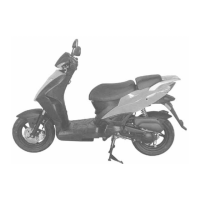
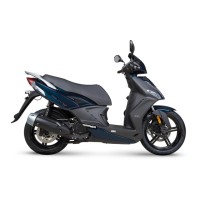

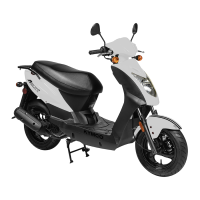
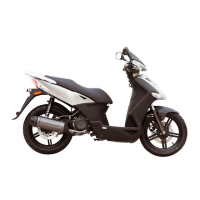
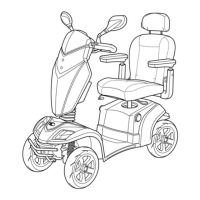


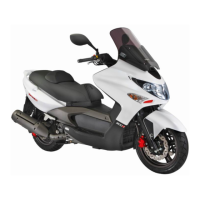
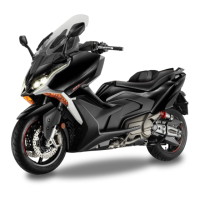
